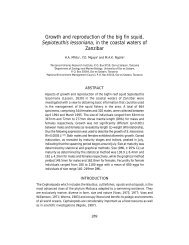gpa_east_africa_case.. - GRID Africa GeoPortal - UNEP
gpa_east_africa_case.. - GRID Africa GeoPortal - UNEP
gpa_east_africa_case.. - GRID Africa GeoPortal - UNEP
Create successful ePaper yourself
Turn your PDF publications into a flip-book with our unique Google optimized e-Paper software.
Property impacts are widely known to depend on surrounding environmental amenity.Coastal and near-coast property is particularly vulnerable to environmental quality. To obtainbetter estimates of the environmental impacts on property value it is necessary to compareproperties with identical or similar characteristics (size, building quality, accessibility, etc.) inpolluted and pollution-free locations to isolate the impact of pollution. It would also bepreferable to use city zoning and land value maps to determine the proportion of residentialproperties falling within the “sphere of influence” of the coastal environment. In the CaseStudies, a conservative percentage of 5-10% reduction / appreciation of value is used on a20-25% of the housing market.The qualitative aspects are even more difficult to assess and require special ContingentValuation (CV) research results. The indirect effects of pollution on recreation (and thebenefits from pollution management) are classified in the Case Studies as qualitative due tolack of questionnaire data estimating people’s willingness-to-pay (WTP) for recreationalopportunities.In other words, the “total” benefits of sewerage infrastructure are under-estimated inthe Case Studies since, of lack of choice, they left out indirect and non-use benefitscomprising a very important category of benefits of potentially high socio-economicvalue, characterised as qualitative.To estimate indirect and particularly non-use benefits, CV studies are required. Such studiesare widely used tools to assess the social valuation of coastal and marine resources and theirbiodiversity significance (The Economic Value of Biodiversity, D. Pearce and D. Moran, 1996,also, Review of the Empirical Biodiversity Literature, Cynthia Cartier & Jack Ruitenbeek,2000). To assess total benefits, special studies should be carried out on resource valuationfocused on the social value of non-market benefits associated with conservation of coastaland marine ecosystems. When no value is given to the quality of non-market resources, dueto lack of estimates, decision-makers would still agree that ecosystem degradation is an"undesirable" environmental issue but may be encouraged to think of it as an issue beyondmanagement solutions and outside the ambit of environmental investment analysis. If such anapproach prevails, how will then proposals for increased investment for coastal zonemanagement be evaluated and justified when coastal ecology is assumed to have zero orunknown social value?Given that CV requires capacity-building and research resources, many Cost-Benefit Studiesconducted within strict time limits underline the fact that the estimated benefits under-estimatethe total value of benefits as they exclude the non-use biodiversity benefits. This perhapsillustrates the fact that despite much methodological progress and impressive results, Cost-Benefit Analysis of environmental management programmes is still a developing perspective.It should therefore be underlined that most Cost Benefit Case Studies, if not all, are at bestpartial, including only some of the total benefits from policy actions. Also, Cost BenefitAnalysis is rarely entirely conclusive and completely accurate in numerical terms. Cost-Benefit Analysis, unlike biophysical analysis, concerns socio-economic responses to pollutionand environmental degradation that can never be studied under strictly controlled “laboratorytype”conditions and, therefore, data and measurement methods are inherently orders-ofmagnitude,subject to margins of error. Nevertheless, the results generated provide importantconclusions about a whole range of benefits that would otherwise remain conceptually vague,and ignored as “inaccurate” and remain outside the decision-making process. The choiceseems to be between using an approximate value for estimating benefits and a zero value.Assuming a zero value is certainly unhelpful as an approach to justify coastal zonemanagement actions.Final Draft Report – Cost Benefit Case StudiesGPA Strategic Action Plan on Sewage, October, 200058



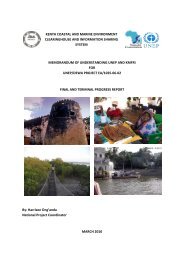
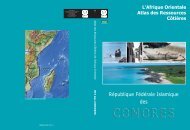
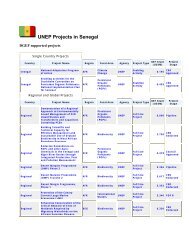

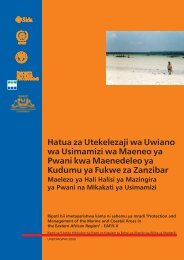
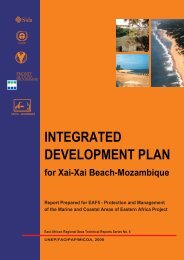
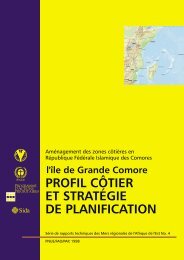
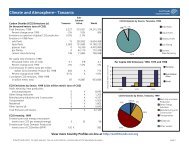

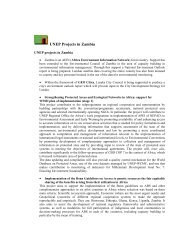
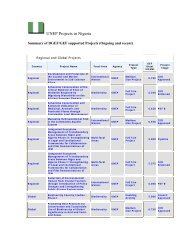
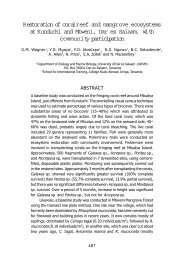
![Please Click to download [English] - GRID Africa GeoPortal - UNEP](https://img.yumpu.com/30633391/1/184x260/please-click-to-download-english-grid-africa-geoportal-unep.jpg?quality=85)
